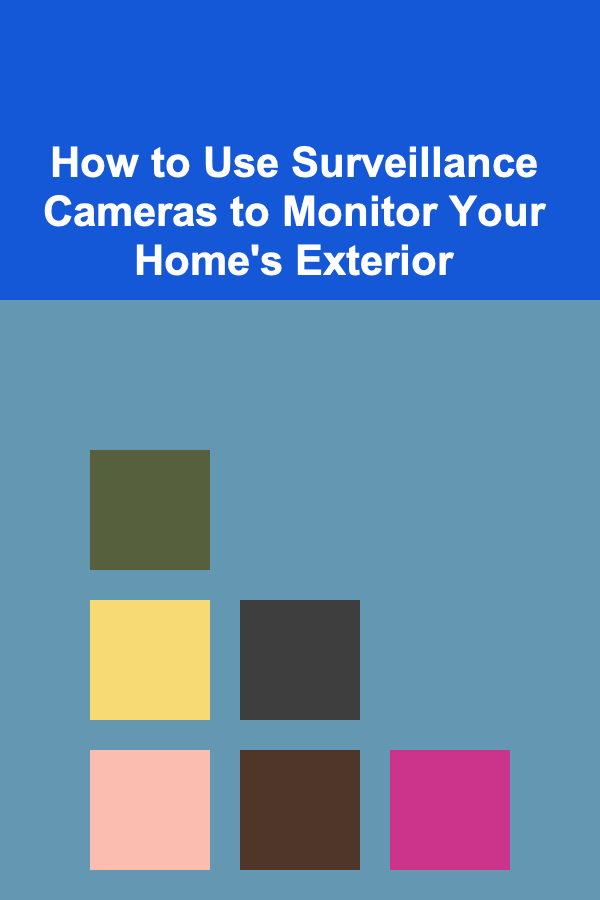
How to Use Surveillance Cameras to Monitor Your Home's Exterior
ebook include PDF & Audio bundle (Micro Guide)
$12.99$10.99
Limited Time Offer! Order within the next:

In today's increasingly digital and connected world, home security has never been more critical. With advancements in technology, surveillance cameras have become a cornerstone of modern security systems. These cameras allow homeowners to monitor the exterior of their homes, providing peace of mind, enhancing safety, and acting as a deterrent against criminal activities.
Using surveillance cameras effectively requires a thorough understanding of the different types of cameras, the ideal placement for optimal coverage, the technology behind them, and how to integrate them into a broader security strategy. In this article, we will explore the various aspects of using surveillance cameras to monitor your home's exterior, offering practical advice and insight into how these systems work.
The Importance of Surveillance Cameras
Before delving into the specifics of how to use surveillance cameras, it's essential to understand their value in modern home security. Surveillance cameras help in:
- Deter Criminal Activity: The mere presence of cameras can often discourage potential burglars or vandals. Criminals are less likely to target homes that are visibly monitored, knowing their actions may be recorded and used against them.
- Real-time Monitoring: Surveillance cameras allow homeowners to monitor their property in real-time, either through a connected app or a monitoring station. This capability enables prompt action in case of an emergency.
- Evidence Collection: In the event of a break-in, trespassing, or vandalism, the footage captured by surveillance cameras can serve as crucial evidence. This evidence can be vital for law enforcement investigations and insurance claims.
- Remote Access: Modern surveillance cameras offer remote access via smartphones or computers, allowing homeowners to monitor their property from anywhere in the world.
- Peace of Mind: Knowing that your home is being monitored gives you peace of mind, especially when you are away for extended periods or when you have vulnerable family members at home.
With these benefits in mind, let's explore how to maximize the effectiveness of surveillance cameras in protecting your home.
Choosing the Right Surveillance Cameras for Your Home's Exterior
Selecting the right cameras for your exterior monitoring is crucial to ensure comprehensive coverage and security. Different types of cameras offer various features, and understanding these will help you make an informed choice.
1. Wired vs. Wireless Cameras
Surveillance cameras come in both wired and wireless versions, each with its advantages and disadvantages.
- Wired Cameras: Wired cameras are generally more reliable because they don't rely on a Wi-Fi connection. They tend to have more stable and consistent video feed quality, and they don't require frequent battery changes. However, installation can be more complex, as they require running cables from the camera to a recording device or monitoring station.
- Wireless Cameras: Wireless cameras are more flexible and easier to install. They connect via Wi-Fi and are often powered by rechargeable batteries or solar panels. However, they can experience connectivity issues if your Wi-Fi signal is weak, and batteries need to be monitored and changed periodically.
Choosing between the two depends on your home's layout, the installation process you're comfortable with, and the level of connectivity you need.
2. Resolution and Image Quality
The resolution of the camera is a critical factor in determining how clear the footage will be. Most modern surveillance cameras offer high-definition (HD) quality, with options for 1080p, 2K, and 4K resolutions.
- 1080p (Full HD): This is the most common resolution for home security cameras. It provides clear images that are usually sufficient for identifying people, vehicles, or events around your home.
- 2K and 4K: These higher resolutions provide even more detailed images, which can be useful if you want to capture finer details, such as facial features or license plates from a distance.
Higher resolution cameras tend to require more bandwidth for video streaming and storage, so it's essential to ensure your network and storage solutions can accommodate the increased data load.
3. Field of View (FOV)
The field of view of a camera determines how much area it can cover. A wider FOV allows the camera to capture more of the exterior of your home, reducing the number of cameras needed to monitor large areas.
- Wide-Angle Lenses: Cameras with wide-angle lenses (usually between 120 to 180 degrees) offer broader coverage, which can help you monitor larger sections of your property.
- Pan-and-Tilt Cameras: Some surveillance cameras allow for remote control of the camera's angle, letting you adjust the view as needed. These are particularly useful if you want to focus on specific areas at different times.
Choosing the right FOV is crucial for maximizing coverage while minimizing blind spots around your property.
4. Night Vision and Motion Detection
A large portion of home security threats happen during the night when visibility is low. Therefore, having cameras equipped with night vision is essential for continuous monitoring.
- Infrared (IR) Night Vision: Most modern surveillance cameras come with infrared LED lights that allow the camera to capture clear images in low-light conditions. Look for cameras with a range of at least 20-30 feet to ensure visibility even in dark corners.
- Motion Detection: Many cameras come with motion sensors that activate recording only when motion is detected. This can save storage space and allow you to focus on relevant footage. Some cameras also send alerts to your smartphone when motion is detected, so you can take immediate action.
5. Weather Resistance
Since these cameras will be placed outdoors, they must be built to withstand various weather conditions. Look for cameras that are rated with an IP (Ingress Protection) rating, which indicates the level of protection against dust and water.
- IP66 or IP67: These ratings signify that the camera is weatherproof and can withstand heavy rain and dust. If you live in an area with extreme weather conditions, make sure to choose cameras designed for such environments.
Proper Placement of Surveillance Cameras
Once you've selected the right surveillance cameras, the next step is to ensure that they are strategically placed around your property for maximum coverage. The placement of cameras is just as important as the quality of the cameras themselves.
1. Front Door and Porch
The front door is a common entry point for burglars, so placing a camera here is essential. A camera focused on the front door allows you to monitor deliveries, visitors, and potential intruders.
- Positioning: Install the camera at an elevated height, preferably near the top of the door frame, to get a clear view of anyone approaching the door.
- Visibility: Make sure the camera is visible, as this can act as a deterrent. However, ensure it is not too obvious, as burglars might attempt to disable it if they spot it right away.
2. Driveway and Garage
Your driveway is another critical area to monitor, as it can provide access to your garage or allow burglars to park nearby and approach your home unnoticed.
- Positioning: A camera placed near the garage can help you monitor the driveway and detect suspicious vehicles or individuals approaching your home.
- Additional Coverage: If you have a large driveway, consider using a camera with a wide FOV or one that offers pan-and-tilt capabilities to adjust the view as needed.
3. Backyard and Side Gates
Backyards and side gates can provide an entry point for intruders, especially if your property is secluded or shielded by fences. Surveillance cameras here help monitor these vulnerable areas.
- Positioning: Place cameras at high points along the perimeter of your yard or near fences, making sure to cover both gates and hidden corners.
- Avoid Blind Spots: Be mindful of any obstructions, such as trees, that could block the view of the camera. Ensure the camera covers all possible entry points.
4. Porch and Entryways
If you have additional entryways, such as a side door or a rear entrance, install cameras that cover these areas as well. Criminals often target lesser-known entrances, so monitoring these can help provide comprehensive coverage.
- Positioning: Install cameras at angles where they can capture anyone approaching or entering through these secondary doors.
5. Windows
Windows, particularly those that are ground-level or near your front or back door, can be vulnerable points of entry. Position cameras to cover windows that are near access points or hidden from the general view.
- Positioning: Place cameras high up to monitor windows or near the top of your building's exterior. Ensure they cover the full window area to capture any suspicious activity.
Integrating Surveillance Cameras into a Broader Security Strategy
While surveillance cameras are crucial for monitoring your home's exterior, they should be integrated into a broader home security system for maximum effectiveness. Here are some key integrations to consider:
1. Smart Home Integration
Many modern surveillance cameras integrate with smart home systems, allowing you to control them alongside other smart devices such as lights, alarms, and locks. This integration enables you to set up automation and triggers, such as turning on the porch light when motion is detected.
2. Security Alarms
Linking your cameras to a security alarm system can provide an added layer of protection. For example, if a camera detects motion, it can trigger an alarm or send an alert to your phone or security company.
3. Cloud Storage and Backup
Storing surveillance footage is essential for reviewing events and gathering evidence. Many surveillance cameras offer cloud storage options for securely backing up footage. It's important to have a reliable storage solution in place, whether it's local storage or cloud-based, to ensure your footage is not lost.
Conclusion
Using surveillance cameras to monitor your home's exterior is an effective and powerful way to enhance home security. By choosing the right cameras, placing them strategically, and integrating them into a broader security system, you can ensure your property is well-protected from potential threats. With the right technology and strategic planning, surveillance cameras not only deter criminals but also provide invaluable evidence in the event of an incident. Take the time to set up a robust surveillance system today to safeguard your home and loved ones tomorrow.
Reading More From Our Other Websites
- [Personal Finance Management 101] How to Plan for Retirement: Tips for Every Age
- [Home Budget 101] How to Save Money on Your Monthly Grocery Bill
- [Home Rental Property 101] How to Add Smart Home Features to Your Rental Property
- [Home Security 101] How to Secure Your Home When You Have Children and Pets
- [Home Maintenance 101] How to Find Reliable Appliance Repair Services Near You
- [Ziplining Tip 101] Harness the Power of Gravity: Building Endurance and Power Through Ziplining
- [Stamp Making Tip 101] Step-by-Step Guide to Crafting Custom Rubber Stamps for Scrapbooking
- [Personal Financial Planning 101] How to Understand and Use Asset Allocation to Reduce Risk
- [Organization Tip 101] What Are the Best Practices for Organizing Your Bathroom?
- [Home Budget Decorating 101] How to Incorporate Vintage Decor Into Your Home Without Spending a Fortune

How to Build Customized Storage for Small Bedrooms
Read More
How to Schedule Apartment Viewings and What to Look For: An Actionable Guide
Read More
How to Use Color Coding for Easy Identification of Supplies
Read More
How to Begin Contributing to Open Source AI
Read More
How To Negotiate Lower Bills and Subscriptions: An In-Depth Guide
Read More10 Tips for Keeping Your Vendor Payment Tracker Accurate
Read MoreOther Products

How to Build Customized Storage for Small Bedrooms
Read More
How to Schedule Apartment Viewings and What to Look For: An Actionable Guide
Read More
How to Use Color Coding for Easy Identification of Supplies
Read More
How to Begin Contributing to Open Source AI
Read More